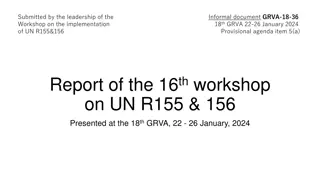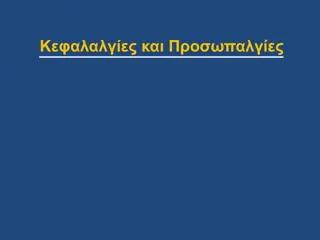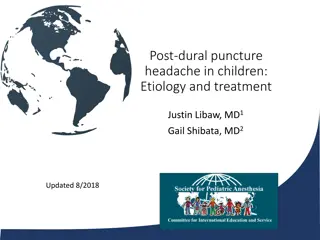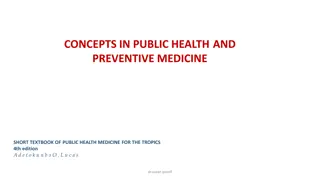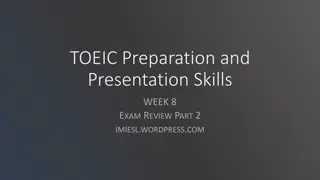Overview of UCNS Headache Medicine Exam and Recertification Process
Learn about the UCNS Headache Medicine Exam, recertification requirements, and the importance of maintaining certification in this subspecialty. Discover the demographics of UCNS diplomates, recertification criteria, and the year-wise CME credits needed for certification renewal. Stay informed about the ongoing commitment to excellence in headache medicine practice.
Download Presentation

Please find below an Image/Link to download the presentation.
The content on the website is provided AS IS for your information and personal use only. It may not be sold, licensed, or shared on other websites without obtaining consent from the author.If you encounter any issues during the download, it is possible that the publisher has removed the file from their server.
You are allowed to download the files provided on this website for personal or commercial use, subject to the condition that they are used lawfully. All files are the property of their respective owners.
The content on the website is provided AS IS for your information and personal use only. It may not be sold, licensed, or shared on other websites without obtaining consent from the author.
E N D
Presentation Transcript
Introduction to the UCNS Headache Medicine Exam Noah Rosen, MD FAHS Zucker Hofstra School of Medicine Long Island NY
3 Disclosures Allergan: Amgen: Promius Pharma: Advisory Board Supernus: Advisory Board Teva: Advisory Board Eli Lilly: Advisory Board, Research Support Curelator: Consultant paid in options Advisory Board, Research Support, Speaker s Panel Advisory Board Reference Arial 10pt left aligned Footer Arial 10pt right aligned
4 Why is Recertification Still Important? The UCNS believes that recertification demonstrates the diplomate s ongoing commitment to excellence in his or her subspecialty. By complying with recertification requirements, you not only advance your knowledge but also demonstrate your commitment to the highest quality patient care. No impact (still) on reimbursement rates or on credentialing Most practitioners are NOT certified. Reference Arial 10pt left aligned Footer Arial 10pt right aligned
5 Demographics 484 (520) Diplomates spread over 46 States, Washington DC and Canada 4 States remain unrepresented Grandfathering Period has reopened for the next 2 exam cycles. Must complete clinical requirements or UCNS approved fellowship 40 programs now on UCNS website Work is now being done on updating MOC Likely to mirror that of primary specialty May persist even if ABMS recognition Reference Arial 10pt left aligned Footer Arial 10pt right aligned
Requirements for Recertification UCNS diplomates must meet the following four requirements: maintain a current, active, valid, unrestricted, and unqualified license to practice medicine remain a diplomate in good standing in their primary specialty of the ABMS or RCPSC member board that was required for initial certification complete a specified number of ACCME- or RSPC-approved category 1 CME hours, 20% of which must be subspecialty specific, and take and pass a recertification examination.
Year of Certification or Recertification Certification Expiration CME Credits Required (20% of which must be subspecialty- specific) Specialty Certification by ABMS Board or RCPSC Professional Standing (Medical Licensure) 2008 2018 240 (48) 2009 2019 270 (54) 2010 2020 300 (60) Must Maintain throughout 10-year cycle Must Maintain throughout 10-year cycle 2011 2021 300 (60) 2012 2022 300 (60) 2013 2023 300 (60) 2014 2024 300 (60) 2015 2025 300 (60)
Initial Examination The initial examination in Headache Medicine has 200 multiple-choice questions that are computer- based. The fee for this examination is $1,700. Applications for the 2018 initial and recertification examination are now over but It is not too late to take it again!
Recertification Examination The recertification examination will have 150 multiple-choice questions that are computer- based. The fee for this examination is $1,500+. The recertification examination will be offered the fall of 2018
Exam Content Content Area Percentage of Questions I. Epidemiology and Comorbidity 10% II. Anatomy and Physiology 15% (decrease) III. Headache Classification and Diagnosis 20% IV. Evaluation and Diagnostic Testing 20% IV. Treatment 35% (increase)
Exam Content I. Epidemiology and Comorbidity A. Epidemiologic Principles 1. Headache 2. Migraine 3. Cluster 4. Chronic migraine B. Comorbidities of Migraine 1. Neurologic 2. Psychiatric 3. Other
Exam Content II. Anatomy and Physiology A. Pain Mechanisms 1. Peripheral and central trigeminal pain physiology and anatomy 2. Nociceptive neurotransmission (neuropeptides/neurotransmitters) 3. Peripheral and central sensitization 4. Pain modulation pathways (central antinociceptive network hypothalamus, periacqueductal grey, raphe nuclei, locus coeruleus, limbic system) B. Pathophysiology 1. Head and face pain models 2. Individual disorders C. Headache Pharmacology
Exam Content III. Headache Classification and Diagnosis A. International Classification of Headache Disorders - 3 B. Primary and Secondary Headache Differentiation (e.g., thunderclap, first or worst, new features) C. Primary Headache 1. Migraine 2. Tension type 3. Cluster and other TACs 4. Neuralgias 5. Chronic migraine and other chronic headache disorders D. Secondary Headache, including but not limited to: 1. Stroke 2. Venous sinus thrombosis 3. Arthritis (Arteritis?) 4. Vascular disorders *(aneurysm, arterial dissection, RCVS) 5. Brain tumor 6. Sinusitis 7. Meningitis and encephalitis 8. Intracranial pressure abnormalities 9. Toxic and metabolic 10. Disorders of homeostasis 11. Medication overuse 12. Dental, temporomandibular joint disorders 13. Cervicogenic E. Pediatric Headache 1. Migraine 2. Episodic syndromes 3. Trauma or injury to the head and/or neck
Exam Content IV. Evaluation and Diagnostic Testing A. History and Physical Examination B. Imaging 1. Computed tomography (CT), CT angiography 2. Magnetic resonance imaging (MRI), MR angiography, MR venography 3. CT and MRI myelography 4. Catheter angiography 5. X-ray (spine and skull) C. Lumbar Puncture 1. Diagnostic 2. Therapeutic D. Radionuclide Cisternography E. Electroencephalography (EEG) F. Other 1. Polysomnography 2. Tissue biopsy 3. Blood tests 4. Electrocardiogram, echocardiogram 5. Ultrasound (e.g. transcranial Doppler)
Exam Content V. Treatment A. Principles of Disease Management and Evidence Based Practice B. Patient Communication 1. Education 2. Counseling C. Therapeutic Modalities 1. Behavioral and non-pharmacologic 2. Pharmacologic 3. Physical techniques including but not limited to nerve blocks, cervical facet joint injections, trigger point injections, botulinum toxin, acupuncture, physical therapy and exercise D. Advanced Therapies 1. Parenteral therapy 2. Inpatient treatment 3. Ablative therapy (trigeminal rhizotomy, trigeminal section) 4. CNS treatments (e.g. shunts, deep brain stimulation) 5. PNS treatments (e.g. occipital nerve stimulation) E. Individual Disorders 1. Primary headaches 2. Secondary headaches 3. Chronic headache (primary and secondary) F. Special Populations 1. Pediatric 2. Pregnancy 3. Elderly 4. Concurrent medical illness 5. Post-traumatic headache





